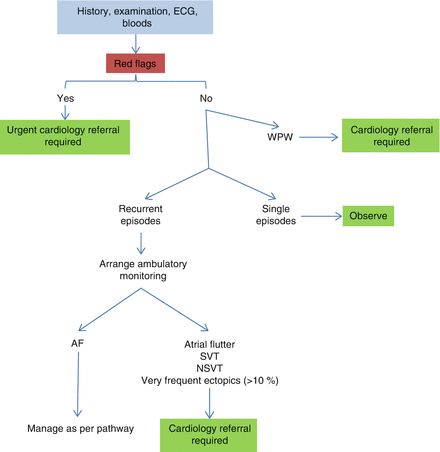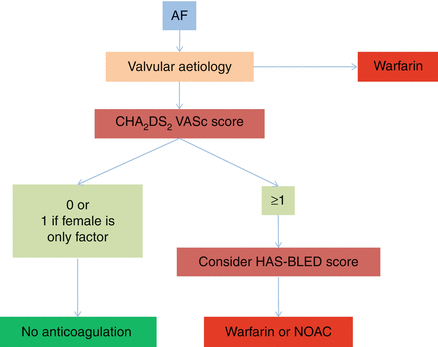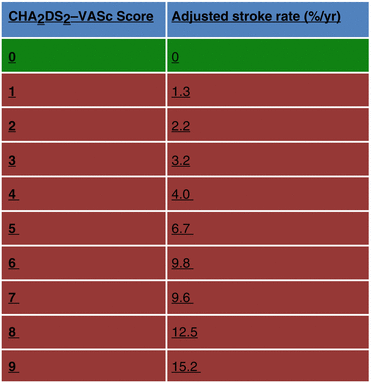Figure 3.1
Classification of palpitations according to history and ECG findings. Abbreviations: SVT supraventricular tachycardia, AVNRT atrioventricular nodal reentry tachycardia, AVRT atrioventricular reentry tachycardia, AT atrial tachycardia
General Patient Approach
Patients presenting with palpitations are commonly asymptomatic at the time of presentation. In this case, the focus should be on determining the severity of associated symptoms with a particular emphasis on red flag symptoms, the likely presence or absence of structural heart disease and common reversible causes of arrhythmia. Palpitations in individuals without evidence of structural or functional heart disease generally carry a benign prognosis, except in the rare inherited primary arrhythmia syndromes, such as the long QT and Brugada syndromes.
History
Symptoms
Arrhythmias can manifest with a wide variety of associated symptoms. However, the uncovering of certain “red flag” symptoms or features should prompt referral to a specialist, as they may point to a potentially serious cause (Table 3.1).
Table 3.1
Red flags
Palpitations with syncope/pre-syncope |
Palpitations that worsen with exercise |
Family history of inherited heart disease or premature unexplained sudden death |
High risk structural or functional heart disease |
e.g. myocardial infarction, congenital heart disease, cardiomyopathy |
Important clues gained from the history may suggest a specific underlying arrhythmia. Ectopic beats are described commonly as pauses (“skipped beats”) followed by a more forceful heartbeat. Irregularity may indicate AF or atrial flutter with variable conduction, though frequent ectopy can also be described in this way. Abrupt onset and offset of palpitations commonly occur in pathological supraventricular tachycardias (SVT), as opposed to gradual onset and offset associated with sinus tachycardia. Furthermore, polyuria following termination of palpitations may also point towards SVT; polyuria results from natriuretic peptide release in response to atrial stretch. Reliable termination of palpitations with atrioventricular (AV) node blockade (pharmacological or physiological) is highly suggestive of common forms of SVT. Thus, patients may report that vagal manoeuvres such as coughing or Valsalva resolve symptoms. A history of palpitations since childhood may also indicate that SVT involving an accessory pathway (atrioventricular re-entry tachycardia; AVRT) could be the mechanism. Conversely, atrial arrhythmias occur more often in older patients.
Medical History and Examination
Clues from a patient’s medical history may also point toward certain forms of arrhythmia. A history of pulmonary disease increases the likelihood of atrial tachycardia (AT). Similarly, mitral valve disease predisposes to AF. A history of possible myocardial scarring, such as prior myocardial infarction or cardiomyopathy should be sought, as their presence in the context of syncope is ominous and points to possible life-threatening ventricular arrhythmias requiring urgent evaluation by a cardiologist.
A multitude of medications may precipitate arrhythmia. Common classes of medications that trigger or exacerbate arrhythmias are the beta agonists, thyroxine and theophyllines amongst others. Over the counter medications such as cough/cold medicines, decongestants and nutritional supplements containing stimulants such as caffeine or guarana can similarly precipitate arrhythmias. Illicit use of amphetamines and cocaine should also be elicited. Alcohol overconsumption should be viewed as a precipitant for AF.
A careful family history is important to identify a potentially inheritable condition. A history of sudden unexplained death under the age of 45 years may indicate heritable cardiac causes such as hypertrophic cardiomyopathy or ion-channel disorders such as the long QT syndrome, Brugada syndrome and catecholaminergic polymorphic ventricular tachycardia (CPVT).
Most patients who present with symptoms of arrhythmia are asymptomatic during the consultation and physical examination is often unrevealing. However, abnormal heart sounds or signs of heart failure indicate the presence of structural heart disease, which predisposes to the development of AF and ventricular tachycardia (VT).
Investigations
Baseline investigations should involve full blood count, electrolytes and thyroid function to exclude anaemia, electrolyte abnormalities and thyroid dysfunction.
A 12-lead ECG should be taken even when asymptomatic at the time of acquisition as it may reveal clues as to the presence of underlying heart disease. As ECG abnormalities may be subtle, it is recommended that the ECG be interpreted by people with the necessary expertise; abnormalities to be scrutinised for are listed in Table 3.2.
Table 3.2
ECG abnormalities during sinus rhythm
Abnormality | Possible cause |
|---|---|
Short PR interval and delta wave | WPW – AVRT |
Q waves | Prior MI – VT/AF |
P mitrale | Enlarged LA – AF |
Prolonged QT interval | Long QT syndrome – VF |
ST shift / T wave inversion | HCM – VT/AF ARVC – VT/AF Prior MI – VT/AF |
In the event that the patient presents with tachycardia, and providing it is not causing severe symptoms and/or haemodynamic instability, an ECG during tachycardia is essential for diagnosis. If the patient experiences sustained palpitations but they are infrequent, then they should be given a covering letter and instructed to attend the local casualty department for an ECG during tachycardia.
Ambulatory monitoring is of use where symptoms are frequent enough to be captured. Frequency of symptoms determine the device to be selected with most hospitals offering 24 h continuous monitoring which is appropriate for patients with palpitations more that 2–3 times in a week and patient activated 7 day loop recorders for those with less frequent symptoms. Monitoring during asymptomatic periods provides limited information and may also lead to false reassurance. Conversely, normal sinus rhythm captured at the time of symptoms can be reassuring.
When to Refer
A suggested criterion for admission of patients presenting with and without symptoms at the time of consultation is shown in Table 3.3 and Fig. 3.2.

Table 3.3
Criteria for emergency admission for patients currently experiencing arrhythmia
Any broad complex tachycardia |
Persistent narrow complex tachycardia despite vagal manoeuvres |
Breathlessness/Chest pain/Syncope/Presyncope |
Hypotension |

Figure 3.2
Referral pathway for patients who are asymptomatic at presentation. Abbreviations: WPW Wolff-Parkinson-White, AF atrial fibrillation, SVT supraventricular tachycardia, NSVT non-sustained ventricular tachycardia
Management of Specific Arrhythmias
Atrial Fibrillation
Atrial fibrillation is the most common sustained arrhythmia worldwide with an estimated prevalence of 1–2 % and is on the rise. It is diagnosed with an ECG demonstrating an irregular RR interval and no distinct P waves (Fig. 3.3). The presence of AF is an independent risk factor for increased mortality and morbidity and carries an approximate 5 fold increased risk of stroke, hospitalisation and 3 fold risk of heart failure. AF is traditionally classified as paroxysmal if duration of episodes is <7 days, persistent if >7 days duration and permanent (or chronic persistent) if it is accepted in the long term.


Figure 3.3
ECG demonstrating AF with irregular QRS complexes and indiscernible P waves
Over the last few years, the management of AF has evolved considerably with the availability of the novel oral anticoagulants (NOAC) and the increasing role of interventions such as ablation.
The goals of AF management are:
1.
Assessment of stroke risk and antithrombotic therapy.
2.
Treatment of symptoms with rate or rhythm control
3.
Treatment of underlying disease processes.
Stroke Risk Assessment and Anticoagulation
Screening
Screening of individuals aged over 65 years by pulse palpation followed by routine ECG in those who have irregularity should be undertaken to prevent complications of AF before they develop.
Stroke Risk Assessment
Anticoagulation therapy in AF is the only treatment that has been firmly shown in multiple trials to reduce stroke risk. Furthermore, when evaluating the need for anticoagulation, the risk of stroke should be considered the same regardless of the pattern or frequency of AF.
Several guidelines have been published on stroke risk stratification of AF from different international organisations since 2006, with the emphasis shifting from identifying those at risk of stroke to establishing those who are truly low risk who do not require antithrombotic treatment. This has been formalised in the CHA2DS2VASc risk score (Fig. 3.4). This approach was driven by data on newer risk factors that showed that those who were classified previously as being low risk by prior risk-stratification scores (including the commonly applied more-limited CHADS2 score) were still at moderate risk and would benefit from anticoagulation. Furthermore, data on the efficacy of aspirin, which has long been thought of as an alternative to warfarin, is unconvincing, particularly in the elderly and has been shown to have similar bleeding risks to that of warfarin. As a result, the role of aspirin has been downgraded and should only be considered where the patient has declined warfarin or a NOAC; unequivocally low-risk individuals require neither antiplatelet nor anticoagulant (Tables 3.4 and 3.5).



Figure 3.4
Anticoagulation decision algorithm – adapted from 2012 ESC guidelines
Table 3.4
Green denotes low risk – anticoagulation not needed. Red denotes high risk – anticoagulation recommended

Table 3.5
CHA2DS2 – VASc Score calculation
Cardiac failure | 1 |
Hypertension | 1 |
Age >75 years | 2 |
Diabetes | 1 |
Stroke/TIA | 2 |
Vascular disease (MI, PVD, aortic plaque) | 1 |
Age 65–74 | 1 |
Sex Category female | 1 |
Bleeding Risk Assessment
It has been shown that despite the superiority of oral anticoagulation in preventing strokes, studies have consistently demonstrated its underuse in high-risk patients and a high rate of discontinuation. Reasons for this are several fold and include age, fall risk and bleeding risk, which tend to be overestimated by physicians. The HAS-BLED score has recently been developed to provide a more objective bleeding risk assessment and identifies potentially correctable risk factors (Table 3.6). In patients with a score of ≥3, caution should be exercised and regular review undertaken, but should not be used in isolation to exclude patients from anticoagulant therapy.
Table 3.6
HAS-BLED Score calculation
Feature | Score |
|---|---|
Hypertension (Systolic >160 mmHg) | 1 |
Abnormal renal or liver function | 1 or 2 |
Stroke | 1 |
Bleeding history or predisposition (anaemia) | 1 |
Labile INR (therapeutic time in range <60 %) | 1 |
Elderly ≥ 65 years | 1 |
Drugs (antiplatelets, NSAIDs) or alcohol excess | 1 or 2 |
Antithrombotic Therapy
The choice of agents for thromboprophylaxis has rapidly expanded in the last few years and novel oral anticoagulants (NOAC) and antiplatelet agents have been extensively investigated in large randomized trials. However, the costs of the newer NOAC may – at least initially – restrict their use to defined groups of patients, despite their efficacy.
As stated previously, the evidence for aspirin in stroke prevention is weak and the risks of major bleeding and intracranial haemorrhage should be considered similar to warfarin, particularly in the elderly. Furthermore, there is no evidence that aspirin reduces cardiovascular mortality in the AF population. The addition of clopidogrel to aspirin is superior to aspirin alone, however with the disadvantage of a greater bleeding risk than warfarin. Warfarin has been the gold standard for many years, with a reduction in risk of stroke by 64 % overall with a major bleeding rate of 3.6 % per year and risk of intracranial haemorrhage of 0.7 % per year. However, its disadvantages include the need for regular blood tests in view of its variability in metabolism. As such, it has been shown that even in the most rigorously conducted trials, patients receiving “optimal” warfarin management were within therapeutic range for only 63 % of the time and is likely to be considerably less in a community setting.
The NOACs dabigatran (Pradaxa), rivaroxaban (Xarelto) and apixaban (Eliquist) have recently been approved for use in the UK by NICE. A comparison of each agent can be seen in Table 3.7. So far, there have been no head to head trials of one NOAC against another, so comparisons on efficacy cannot be made. Currently, robust data exists only for their use in non-valvular AF and there is sparse data beyond this.
Table 3.7
Oral anticoagulant options for stroke prevention in atrial fibrillation
Warfarin | Dabigatran | Rivaroxaban | Apixaban | |
|---|---|---|---|---|
Dosing | Variable OD < div class='tao-gold-member'>
Only gold members can continue reading. Log In or Register to continue
Stay updated, free articles. Join our Telegram channel
Full access? Get Clinical Tree
 Get Clinical Tree app for offline access
Get Clinical Tree app for offline access

|